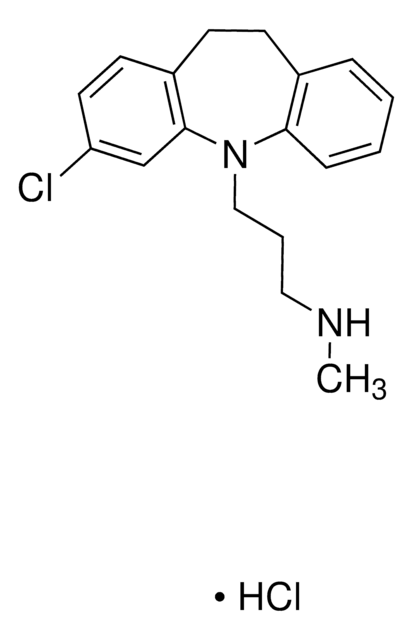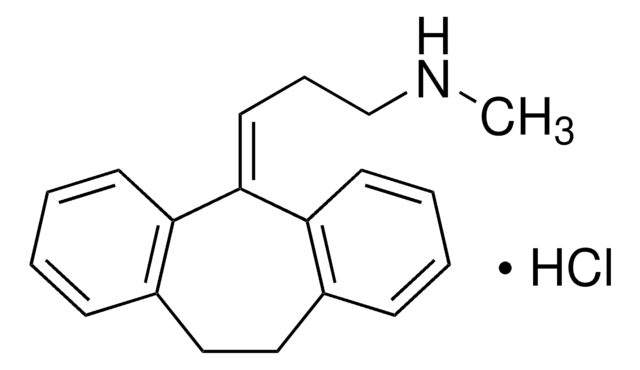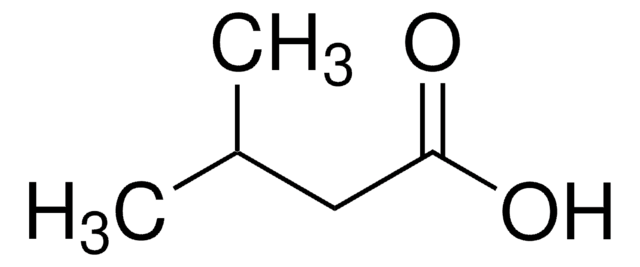P1386
Propionic acid
≥99.5%
Sinonimo/i:
Acid C3, Propanoic acid, Propanyl acid
About This Item
Prodotti consigliati
Densità del vapore
2.55 (vs air)
Tensione di vapore
2.4 mmHg ( 20 °C)
Saggio
≥99.5%
Temp. autoaccensione
955 °F
Limite di esplosione
12.1 %
Impurezze
≤0.25% water (Karl Fischer)
Colore
≤10, APHA:
Indice di rifrazione
n20/D 1.386 (lit.)
P. ebollizione
141 °C (lit.)
Punto di fusione
−24-−23 °C (lit.)
Densità
0.993 g/mL at 25 °C (lit.)
Stringa SMILE
CCC(O)=O
InChI
1S/C3H6O2/c1-2-3(4)5/h2H2,1H3,(H,4,5)
XBDQKXXYIPTUBI-UHFFFAOYSA-N
Cerchi prodotti simili? Visita Guida al confronto tra prodotti
Descrizione generale
Applicazioni
- Distribution Characteristics of Low-Molecular-Weight Organic Acids in Reclaimed Soil Filled with Fly Ash: A Study.: This research investigates the presence and distribution of propionic acid among other organic acids in reclaimed soils treated with fly ash. The study provides insights into the environmental impact and potential remediation strategies for soils contaminated with industrial by-products (Zheng et al., 2024).
- Effects of Black Soldier Fly (Hermetia illucens L., BSF) Larvae Addition on In Vitro Fermentation Parameters of Goat Diets.: This study examines how the addition of black soldier fly larvae affects the fermentation process of goat diets, including the production of propionic acid. The findings suggest potential benefits for improving animal nutrition and gut health (Lu et al., 2024).
- NMR Spectroscopy in Diagnosis and Monitoring of Methylmalonic and Propionic Acidemias.: This review highlights the use of NMR spectroscopy to diagnose and monitor methylmalonic and propionic acidemias, providing a non-invasive method for tracking these metabolic disorders. The study underscores the clinical significance of propionic acid in metabolic research (Deleanu & Nicolescu, 2024).
- The New Buffer Salt-Protected Sodium Butyrate Promotes Growth Performance by Improving Intestinal Histomorphology, Barrier Function, Antioxidative Capacity, and Microbiota Community of Broilers.: This study explores how propionic acid, along with sodium butyrate, improves the growth performance and gut health of broilers. The research demonstrates the beneficial effects of these acids on poultry farming (Melaku et al., 2024).
- Prevotella enterotype associates with diets supporting acidic faecal pH and production of propionic acid by microbiota.: This study links the presence of the Prevotella enterotype in the gut microbiota to diets that promote the production of propionic acid, emphasizing the role of diet in modulating gut health and metabolic functions (Adamberg & Adamberg, 2024).
Avvertenze
Danger
Indicazioni di pericolo
Consigli di prudenza
Classi di pericolo
Eye Dam. 1 - Flam. Liq. 3 - Skin Corr. 1B - STOT SE 3
Organi bersaglio
Respiratory system
Codice della classe di stoccaggio
3 - Flammable liquids
Classe di pericolosità dell'acqua (WGK)
WGK 1
Punto d’infiammabilità (°F)
129.2 °F - closed cup
Punto d’infiammabilità (°C)
54 °C - closed cup
Scegli una delle versioni più recenti:
Possiedi già questo prodotto?
I documenti relativi ai prodotti acquistati recentemente sono disponibili nell’Archivio dei documenti.
I clienti hanno visto anche
Il team dei nostri ricercatori vanta grande esperienza in tutte le aree della ricerca quali Life Science, scienza dei materiali, sintesi chimica, cromatografia, discipline analitiche, ecc..
Contatta l'Assistenza Tecnica.











